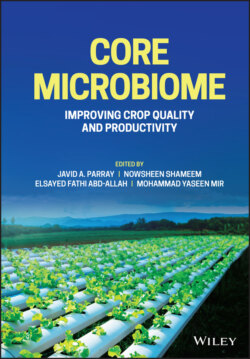Читать книгу Core Microbiome - Группа авторов - Страница 54
3.7 Biological Control and Plant Improvement
ОглавлениеPlant–microbe interaction proves to have increased plant growth directly by stimulating nutrient availability or hormonal production or indirectly by suppressing plant pathogens. Many rhizobacteria strains, such as Bacillus group, Taphylococcus, and Burkholderia cepacian, promote plant growth. These strains also produced volatile organic compounds (VOCs) that enhance growth (Bitas et al. 2013). Biosurfactants, VOCs, antibiotics, and enzymes are used to suppress the growth of pathogens (Berg et al. 2010). Plant extract with antifungal activity is used to suppress pathogens and increase the growth of medicinal plants. Medicinal plants effectively control the development of diseases caused by Macrophomina phaseolina. It is also reported that medicinal plants exhibited varying degrees of inhibition activity against M. phaseolina. Different concentrations of Cleome viscose, Hyptis sueolences, Grewia arborea, Avicennia officinalis, Ocimum, Tephrosia villosa, Peltophorum pterophorus, Sesbanian grandiflora, and Terminalia chebula showed high activity with strong antifungal activity against M. phaseolina, while chloroform extracts showed very low activity (Bobbarala et al. 2009).
Biological compounds produced by medicinal plants depend on microbes, plant interaction, plant and microbe species, and soil types (Morsy 2014). These metabolites produced by medicinal plants have a strong effect on biological and physiological pathways and help them withstand harsh environments. Solanum distichum, Matricaria chamomilla, and Calendula officinalis showed an antagonistic effect in the bacterial rhizosphere (Köberl et al. 2013). Ajuga bracteosa is a medicinal plant used to cultivate diverse root-associated bacteria for plant growth promotion. About 123 different morphological bacteria were isolated from soil and roots. The results predicted in the majority of isolates showed plant growth promotion due to the production of IAA and siderophores (Kumar et al. 2012). Plant growth-promoting rhizobacteria activities include the production of IAA, contributing to phytohormone-regulating plant growth, while siderophores can solubilize iron and make it available for plants. Moreover, the chitinase enzyme that can lyse pathogenic fungal cells inhibits pathogens. Phytochemicals produced by plants affect plant–microbe interaction (Qi et al. 2009). Greater antimicrobial activity was observed in Hypericum plant extract that protects endophytes as compared with Ziziphora that showed lesser antimicrobial characteristics. Moreover, methanol extract exhibited strong antibacterial activity against Bacillus subtilis, E. facecalis, and S. aureus. Chelidonim majus L. and much potential against fungal pathogens (Baker and Satish 2013).
